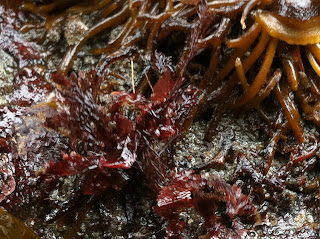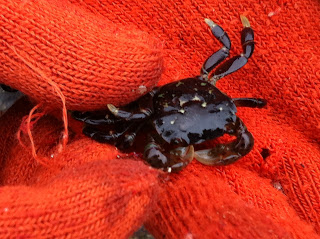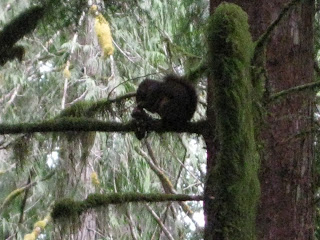Weather: cloudy, interspersed light rain
Temp: 50 F
Time: 1:00pm-6:30pm
Location: Olympic National Park
This weekend we changed locations. Our class packed up and set out to the Olympic Peninsula on the western side of Washington. This location is also home to one of the largest preserved remnants of old growth in the country and one of the only temperate rainforests in the world: Olympic National Park. Of course, when I say "old growth," I should point out, as one of the TA's from class explained, that old growth does not refer to the age of the forest, but rather the degree of complexity (that usually arises out of long term growth...). Old growth forests contain vegetation of varying sizes and ages and organisms within this forest tend to have have complex, intertwined relationships with each other. This brings me to my topic for the week: Interactions. There are many types of interactions in an ecosystem, but I will focus on four of them: facilitation, competition, predation, and disturbance. As we strolled through the forests of the park, we observed the effects of these four interactions...
Facilitation
In my observations, this seemed to me to be the most commonly observable trend. This interaction exists between two organisms where one helps the other, and in the process either receives an exchange of benefits (mutualism) or is unaffected by the interaction (commensalism). The first relationship that becomes apparent in the rainforest is of an epiphytic nature. Mosses abound on trees, even hanging from their very branches, and ferns sprout in the upper crotches of trees. This is because, especially in rainforests, enough moisture hangs in the air that these plants can absorb water almost constantly and require only a little bit of organic matter to accumulate to be able to sprout and survive off the ground. Here, we see a shade-tolerant Dwarf Oregon Grape taking advantage of the bit of shaded area among these tree roots to keep out any sun-seeking competitors.
 |
| Shady business |
| Not my own picture, but you get the idea! |
 |
| Mushroom colony! |
 |
| One TA identified this as saddle fungus(?) |
 |
| Artist's Conk:The disk-shaped fungus usually seen on the sides of dead trees |
 |
| If you look carefully, you can see most of the bumps on this snag are Artist's Conk |
The second ecological relationship exists between two organisms that use the same resources to survive in nature. Here in the forest, in becomes apparent that competition for ground cover drives many vegetative plants to spread out horizontally as well as vertically. We saw two very common, abundant ground species. Salal was a very common ground species, found in nitrogen poor soils, while sword ferns tend to dominate nitrogen rich soils. A need to spread out horizontally has led to the evolution of "runners," or "stolons," which are stems that grow horizontally in order to sprout a new plant in an adjacent area. This can be seen in the Trailing Yellow Violet, viola sempervirens, which we saw much of lining the trail. This flower sends out runners and thus tends to grow in mats, which is something that can help distinguish it from the closely related Stream Violet, viola glabella (there was much debate over which species we were seeing since they look almost identical)
 |
| Viola sempervirens |
 |
| Viola glabella |
Predation
Predation is the act of one species directly consuming another in order to survive. This may be a bit more difficult to observe; however, we did see two examples. One was what appeared to be a deer skull and a few random bones lying on the ground!
 |
| Didn't snap a picture, but it looked a lot like this! |
 |
| Mule deer--look out little guy! |
While we did not see predation on this species, we also observed a Rough-Skinned Newt down by the stream! These have highly poisonous skin, and a bright orange underbelly to warn predators of this fact, in order to keep from being eaten.
 |
| Rough-skinned Newt. Poisonous, so be careful handling! |
Disturbance
The fourth example of interactions deals with some disturbance outside the realm of normal ecosystem flux, in which a force, usually abiotic, that creates a drastic change in the structure or function of some components of the ecosystem. On the Olympic Peninsula, this usually takes the form of landslides or forest fires. Landslides can be common because of the Clawton Clay soil layer in the lower levels of the soil--water permeates to this clay then sit on top of it, causing up layers of soil to slide around on top of the clay. Fires can and have occurred in the Park and can cause new successions to occur. One Western Red Cedar we observed in the park showed charred bark as a legacy mark of the fire, but had actually managed to survive with most of the inner bark burned out of the center while the cambium still remained to continue growth!
Other species we saw in the park included both blue and white versions of the Forget-Me-Not flowers, Vanilla Leaf, several flowering Trillium, False Lily-of-the-Valley, Fairyslipper orchid, Orange Peel Fungus, a Raven, Stellar's Jay, Dark-eyed Junco, and Varied Thrush. See iNaturalist for my observations!
Weather: cloudy, little wind
Temp: 50 F
Time: 10am-12pm
Location: Salt Creek Tideflats (Crescent Bay)
For our second day, we paid a visit to a more marine environment as we explored the intertidal zone of the Salt Creek Tideflats.
Facilitation
Algae and eel grass help provide essential habitat for many small marine creatures, especially for those slow, small creatures such as seahorses that use it to hide in and cling to with their tails.
 |
| Eel grass? |
 |
| Red Algae |
Looking amongst the rocks, we see piles mussels that provide a great substrate for barnacles and snails to attach themselves to and help protect from the waves
 |
| Barnacles and snails attached to Blue Mussel |
Competition
In this ecosystem, heavy competition exists for space on the rock, which provides a great attachment place for these creatures facing constant battering by waves. Mainly, sea stars and mussels show heavy competition, but as you can see, some anenomes like having some rock space as well...
 |
| Bat Star |
 |
| Giant Green Anenome |
Predation
In this ecosystem, algae and eel grass help comprise the lower basis of
the ecosystem functioning by providing a way for energy to be
transferred through photosynthesis to small organisms when they eat these photosynthetic organisms. This energy will
eventually make its way up the food chain to larger organisms through
predation. Near the top of this chain is the Giant Pacific Octopus, which usually preys on shrimp, crabs, fish, clams, etc., though it itself is usually preyed upon by marine mammals such as seals. Unfortunately, this octopus has seen the last of its predating days in Crescent Bay...
 |
| Giant Pacific Octopus |
 |
| Purple Shore Crab. Likely would not have been an octopus meal itself, assuming it stays on the shore, though its marine relatives may have been |
 |
| Tidepool Sculpin. This could also potentially be an octopus meal if washed out to sea! |
Just as was the case for the Rough-Skinned Newt, you can see evolutionary evidence of predation challenges in the physical adaptations of creatures here. Here you can see an example of strong pressure selected towards crabs that look like no more than a bundle of algae as a defense against predation!
 |
| Spider crab(?) or as Tim called it, Hairy Crab |
Disturbance
In the intertidal zone, the tides are a huge creator of daily disturbance. Creatures living in this area must be adapted to both dry and wet lifestyles, as they experience both on a regular basis. Also, the mechanical pounding of the waves can create forces of disturbance through shaping of the rocks, shifting algae, and generally a harsh force to battle against for any organism living here.
More next week when we return to Discovery Park to explore invertebrates!


No comments:
Post a Comment